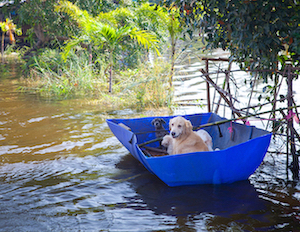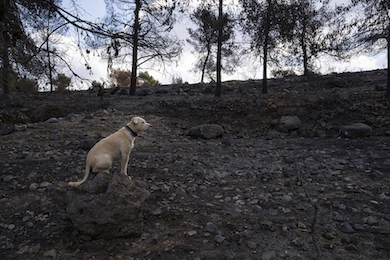Pet Disaster Preparedness: Protect Your Pets from Natural Disasters
Posted: 11/06/2023 | BY: Erin Cain | Categories: Uncategorized
It’s no secret that pets are members of the family. They provide love, companionship, and comfort when we need it most. But pets can’t speak for themselves; they rely on us to ensure they’re safe, especially in natural disasters. That’s why pet disaster preparedness is so important. You can reduce the chance of your pets getting lost, injured, or killed by preparing natural disaster supplies ahead of time. The proper preparation can be the difference between life and death for your pet. Here are some steps you can take to become a prepared pet parent in case of a storm, hurricane, earthquake, tornado, or flood.

Prepare a pet emergency kit.
A pet’s survival kit for natural disasters should include food and water. Put together a disaster kit, one that’s heavy-duty if staying put and sheltering in place, and another lighter weight kit complete with medicines in case evacuation becomes necessary. Here are other items to include in your pet’s emergency kit:
- a pet first aid kit (wound spray, gauze, bandages, tweezers)
- unfrozen, clean water
- at least a two-week supply of treats, food, and water (keep canned food in an airtight container)
- food and water bowls
- manual can opener
- collar, leash, and harness
- warm pet clothes
- pet carrier or crate, especially for smaller pets
- litter and litter box for the cat
- waste bags for dogs
- prescription medication, vaccination records, and medical records (keep in a waterproof container)
- garbage bags and paper towels
- toys, chews, and pet beds
- battery-operated flashlight
- updated and current ID tags, proof of ownership, and a picture of you with your pets
- grooming items
- hand sanitizer and spray disinfectant
- waterproof backpacks and bags
- additional batteries
Having a short and long-term emergency kit for your pet ready whenever you need them is a crucial step toward disaster preparedness for your dog or cat. To prevent additional tragedy, make sure your pet is up to date on all necessary vaccinations.

Have pet carriers ready to go.
When you are preparing for a natural disaster, hurricane, or earthquake, and have to evacuate your home, make sure that your pet can travel comfortably during the process. The best way is by using an expandable or storable crate. This type will allow your pet enough space and be compact enough not to occupy too much room in your vehicle. Portability means everything during these times.
A pen, carrier, or crate can be handy if you and your pet need to shelter at a hotel, evacuation site, a shelter, or a family member or friend’s home. Make sure you know the dimensions of your animal’s travel crate. It should be small enough for your pet to fit in but large enough so that they can stand up and turn around inside it comfortably without feeling cramped or confined.

Create an evacuation plan.
The best way to keep your pets safe during a natural disaster is by taking them with you. If the forecast calls for bad conditions, evacuation may become necessary, and your dog or cat will be at risk if left behind. Have a well-thought-out emergency evacuation plan in place. Research what you’ll need for transportation. Find a list of pet-friendly hotels, rental properties, or the local animal shelter where you and your pet may shelter during a storm or other natural disaster. Contact your local emergency management office for additional evacuation information.
If you have a pet and need emergency shelter, remember that the American Red Cross cannot take in pets. Boarding facilities may be able to care for your dog or cat. If you cannot find a place to accept pets, check with local veterinary offices, which might also have room if needed.
Should you need to evacuate in the middle of winter, ensure your pets are safe. Otherwise, contact someone who has an appropriate vehicle to transport them to a secure place. Make arrangements now, even if you don’t expect any weather-related or natural disasters in your area.
Get by with help from your friends and neighbors.
When a disaster strikes, it is essential to ensure your pets are taken care of by a trusted emergency contact, preferably someone close by, like a trusted neighbor. Your neighbor might be able to take good care of your pet while you’re away from home, just as they would if something happened with one of their pets. If a close neighbor is not available, consider making arrangements with family members to ensure your pet has a safe location to go in an emergency.
Keep your pet’s ID information updated.
It is vital to make sure your dog’s collar tags match their current information. Tags should be easy to read and securely attached, so people can quickly identify your pet and contact you in an emergency. Why does it matter that your pet’s ID tags are current and accurate? Pets often get startled during emergencies. They can be prone to running or hiding, leading them to get lost in a crisis.
If rescuers cannot reach you, you can also list a trusted friend or relative on your dog’s ID tags as a backup contact. Your pet will have an emergency contact person, just like people do. The buddy system is an excellent way to ensure you have a safe alternative for your pet if she needs shelter.
Microchip and register your pet.
Microchipping your pet is the best way to ensure she stays safe and out of trouble. Whether or not they’re ever without their collar, the microchip will always be there with your contact information. Even if they lose the collar or tags, the microchip information can reunite a pet with its owner.
The ID number on your pet’s microchip will help rescuers find you much more quickly than a standard identifier that may fall off or become dirtied and illegible.

What if your pet gets lost?
If your pet is lost during an emergency, be sure to notify local law enforcement and contact local animal control. Check the nearest shelters if your pet was found and surrendered there.
The local Humane Society suggests that pet parents look for their lost pup or cat under a different breed than what’s written down. They advise using additional search terms and checking with your local animal shelters. Also, contact animal control or rescue groups on social media to see if they’ve posted about an animal matching the description that disappeared from its home. Don’t just call — visit the shelters to search for your pet. Many animals are difficult to describe over the phone, and only you know what your pet looks like.
The national locator service websites, like PetFinder and MissingPet911, are also good tools to turn to in your quest to find your pet. An animal welfare organization may also be of service to pet owners with a missing pet.
Pet insurance: another layer of protection.
Pets often suffer injuries in emergencies, and those pets who do come home safe often develop anxiety due to the trauma they’ve experienced. Treating these conditions leads to costly vet bills. Still, a pet insurance policy will help you cover most of those costs. Add another layer of protection for your dog or cat with a pet health insurance plan. Pet Insurance Review finds the best plans for your needs, so don’t wait for an emergency to happen. Get a free quote today!
References:
1. The Humane Society of the United States. (2021). What to do if you lose your pet. Retrieved from https://www.humanesociety.org/resources/what-do-if-you-lose-your-pet
2. PetFinder. (2013). Infographic: Preventing Lost Dogs. Retrieved from https://www.petfinder.com/dogs/lost-and-found-dogs/infographic-preventing-lost-dogs-summersafetytips/
3. MissingPet911. (2021). Browse Lost/Found Pets. Retrieved from http://missingpet911.com/missinPet911/browse-lost-found-pets/
DisclaimerThe information contained on this blog is intended for informational and educational purposes only and should not be construed as medical advice. It is not a substitute for professional veterinary care. Always consult with your veterinarian before making any changes to your pet's health care or treatment plan.
The authors of this blog are not veterinarians and do not claim to be experts in pet health. The information provided here is based on our own experiences and research, as well as information from reputable sources. However, we cannot guarantee the accuracy or completeness of this information.
We encourage you to do your own research and consult with your veterinarian before making any decisions about your pet's health.
Previous post
The Perfect Holiday Activities for PetsCompare top pet insurance providers plans.
Enter your dog’s age in years and months to calculate their age equivalent to human years.
Calculate your dog’s ageEnter your cat’s age in years and months to calculate their age equivalent to human years.
Calculate your cat’s age